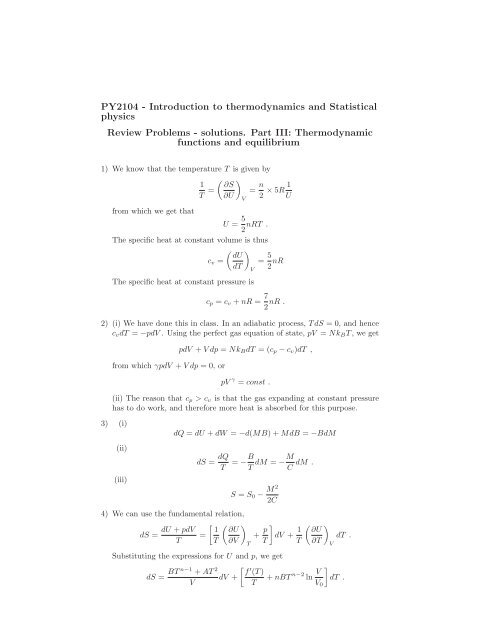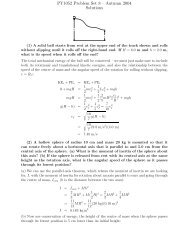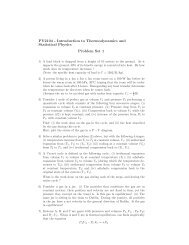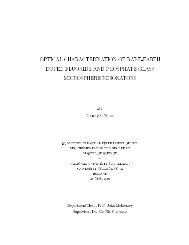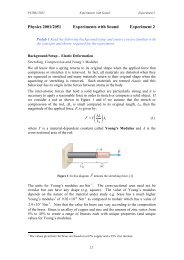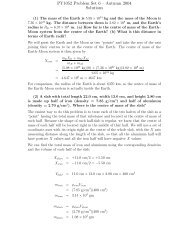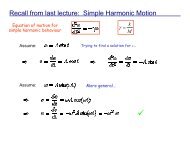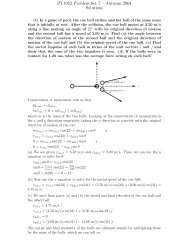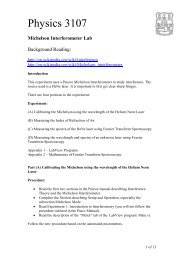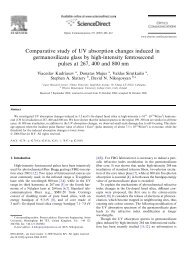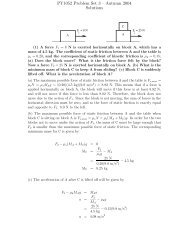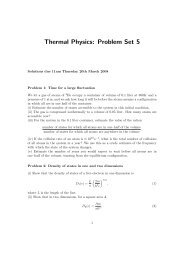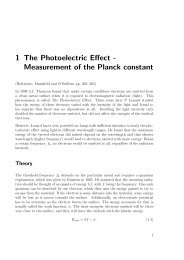PY2104 - Introduction to thermodynamics and Statistical physics ...
PY2104 - Introduction to thermodynamics and Statistical physics ...
PY2104 - Introduction to thermodynamics and Statistical physics ...
You also want an ePaper? Increase the reach of your titles
YUMPU automatically turns print PDFs into web optimized ePapers that Google loves.
<strong>PY2104</strong> - <strong>Introduction</strong> <strong>to</strong> <strong>thermodynamics</strong> <strong>and</strong> <strong>Statistical</strong><br />
<strong>physics</strong><br />
Review Problems - solutions. Part III: Thermodynamic<br />
functions <strong>and</strong> equilibrium<br />
1) We know that the temperature T is given by<br />
( )<br />
1 ∂S<br />
T = = n ∂U 2 ×5R 1 U<br />
from which we get that<br />
V<br />
U = 5 2 nRT .<br />
The specific heat at constant volume is thus<br />
( ) dU<br />
c v = = 5 dT 2 nR<br />
The specific heat at constant pressure is<br />
c p = c v +nR = 7 2 nR .<br />
2) (i) We have done this in class. In an adiabatic process, TdS = 0, <strong>and</strong> hence<br />
c v dT = −pdV. Using the perfect gas equation of state, pV = Nk B T, we get<br />
from which γpdV +Vdp = 0, or<br />
pdV +Vdp = Nk B dT = (c p −c v )dT ,<br />
V<br />
pV γ = const .<br />
(ii) The reason that c p > c v is that the gas exp<strong>and</strong>ing at constant pressure<br />
has <strong>to</strong> do work, <strong>and</strong> therefore more heat is absorbed for this purpose.<br />
3) (i)<br />
(ii)<br />
dQ = dU +dW = −d(MB)+MdB = −BdM<br />
dS = dQ T = −B T dM = −M C dM .<br />
(iii)<br />
S = S 0 − M2<br />
2C<br />
4) We can use the fundamental relation,<br />
[ ( )<br />
dU +pdV 1 ∂U<br />
dS = = + p T T ∂V<br />
T<br />
T<br />
]<br />
dV + 1 T<br />
( ) ∂U<br />
dT .<br />
∂T<br />
V<br />
Substituting the expressions for U <strong>and</strong> p, we get<br />
dS = BTn−1 +AT 2 [ f ′ (T)<br />
dV + +nBT n−2 ln V ]dT .<br />
V T V 0
Using ∂ 2 S/∂T∂V = ∂ 2 S/∂V∂T, we get<br />
(<br />
∂ BT n−1 +AT 2 )<br />
= ∂ [ f ′ (T)<br />
+nBT n−2 ln V ]<br />
∂T V ∂V T V 0<br />
,<br />
from which we get<br />
2AT −BT n−2 = 0 .<br />
The solution must therefore be n = 3 <strong>and</strong> B = 2A.<br />
5) (i) We can write the equation of state as<br />
p = RT<br />
V −b − a<br />
V 2 .<br />
In an isothermal process, the change in Helmholtz free energy is<br />
∆F = − ∫ V 2<br />
V 1<br />
pdV<br />
(<br />
= int<br />
)<br />
V2<br />
( V<br />
dV 2 )<br />
V<br />
= −RT ln 2−b 1<br />
V 1−b<br />
+a<br />
V 1<br />
− 1 V 2<br />
.<br />
RT<br />
V 1 V−b − a<br />
(ii) The change of internal energy can be calculated using<br />
( ) ( ) ∂U ∂U<br />
dU = dT + dV .<br />
∂T ∂V<br />
For an isothermal process, we have<br />
( ) ∂U<br />
dU =<br />
∂V<br />
We can further use<br />
V<br />
( ) ∂U<br />
= T<br />
∂V<br />
T<br />
Using the equation of state, we get<br />
Integrating, we get<br />
∆U =<br />
∫ V2<br />
V 1<br />
T<br />
dV .<br />
T<br />
( ) ∂p<br />
−p<br />
∂T<br />
V<br />
dU = a<br />
V 2dV .<br />
(<br />
a 1<br />
V 2dV = a − 1 )<br />
V 1 V 2<br />
.<br />
6) The entropy is given by<br />
( ) ∂G<br />
S = −<br />
∂T<br />
P<br />
= 5 [ ]<br />
2 R−Rln ap<br />
(RT) 5/2<br />
The specific heat at constant pressure is<br />
( ) ∂S<br />
c p = T = 5 ∂T 2 R .<br />
p<br />
.
7) Let the molar numbers of the gas in the two sides (A) <strong>and</strong> (B) be n 1 <strong>and</strong> n 2 ,<br />
respectively. From the equations of state: pV = n 1 RT <strong>and</strong> 6pV = n 2 RT,<br />
we obtain n 2 = 6n 1 .<br />
(i) The system is isolated <strong>and</strong> containing an ideal gas, <strong>and</strong> therefore the<br />
final temperature is T f = T, since in both sides the initial temperature<br />
is T.<br />
(ii) The final pressure is<br />
p f = (n 1 +n 2 )RT<br />
3V<br />
= p 3<br />
(<br />
1+ n )<br />
2<br />
= 7 n 1 3 p .<br />
(iii) The change in entropy can be calculated by designing a quasi-static<br />
isothermal process. Then,<br />
(∫ )<br />
∆S = 1 T p1 dV 1 +p 2 dV 2<br />
= n 1 R ∫ V 1,f dV<br />
V V +n 2R ∫ V 2,f dV<br />
2V V<br />
= n 1 Rln V 1,f<br />
V +n 2Rln V 2,f<br />
V<br />
Since V 1,f +V 2,f = 3V, <strong>and</strong> V 2,f<br />
V 1,f<br />
= n2<br />
n 1<br />
= 6, we find that V 2,f = 6V 1,f =<br />
18<br />
7 V. Thus, ∆S = n 1 Rln 3 7 +n 2Rln 9 7 ≈ 2 pV<br />
3 T .


